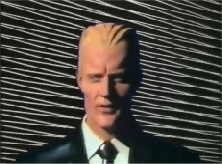
TV Pop Diaries
Pop Music on British Television 1955 -
Max was created by Peter Wagg, head of creative services at Chrysalis Records in
London and George Stone, then working for an advertising agency. The name came first
and after making connections with Andy Park at Channel 4 TV they were given the go-
Video directors Rocky Morton and Annabel Jankel had been successfully directing promo clips for the likes of Elvis Costello and Donald Fagen through their Cucumber productions company since the late seventies, but were now considering moving in to TV and, eventually, movies.
Morton and Jankel directed the initial one-
Having Chrysalis as the show's producer gave them access to Midge Ure and Chris Cross from Ultravox to provide the score, however Ure later complained about how little music was actually used in the final result.
In the real world Max became a star very quickly, appearing in his own series on Cinemax in the US and Channel 4 in the UK, while his image was used in Coke commercials on TV and even having his own hit single, Paranoimia, with The Art Of Noise. Chat show kings Terry Wogan and David Letterman had him as a guest, albeit on a video screen, while he also guested on Channel 4’s Bliss and The Tube in the summer of 1985.
While the first series saw Max on his own, the second, beginning 22nd July 1986 on
Channel 4, made room for guests like Roger Daltrey, Duran Duran and Boy George, while
the third, beginning 6th January 1987 had an audience present and played host to
film stars and other non-
Like Crocodile Dundee and John Hughes movies Max was everywhere in the late eighties, and then suddenly nowhere. Bar a cameo appearance in the 2015 movie Pixels he was absent for decades, while Matt Frewer continues to have a successful acting career.
THE MAX HEADROOM SHOW
C4 / Chrysalis
6th April 1985 -
